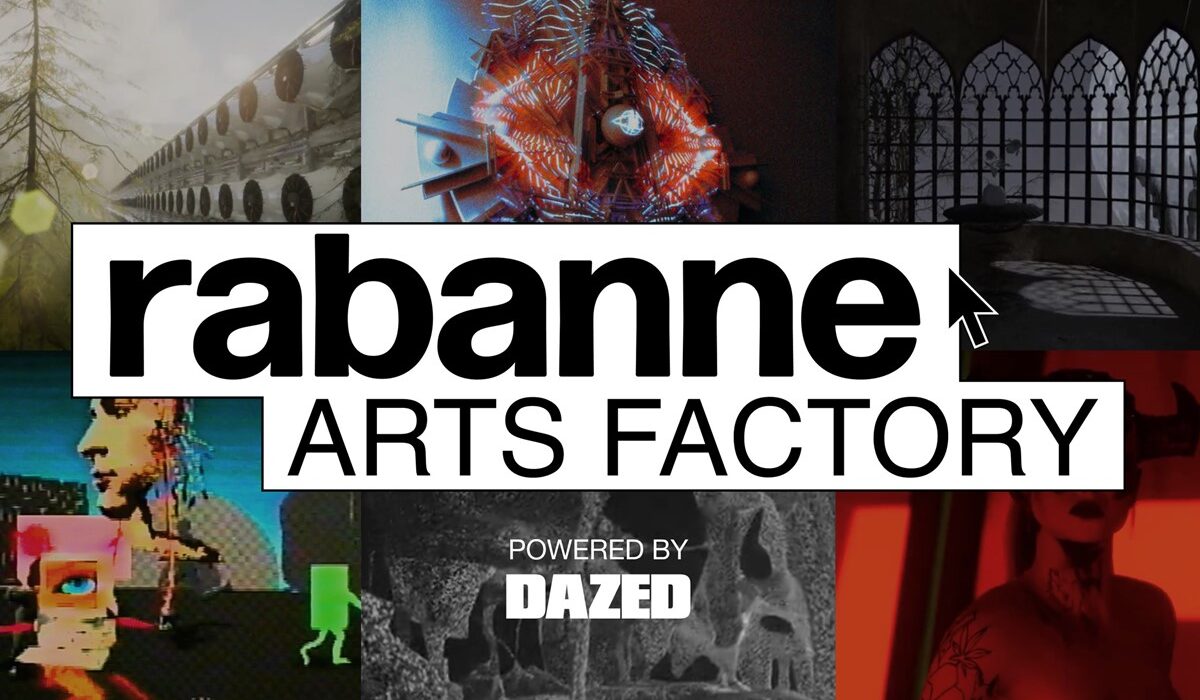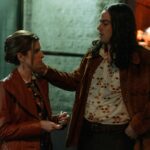Summer in the art world is usually a reason for respite – unless you’re one of the six artist-finalists selected for Rabanne’s inaugural Arts Factory. With the opportunity to showcase their work at Art Basel Miami Beach in December, each finalist spent the sunnier months responding to a brief inspired by Rabanne’s manifesto, emphasising bold creativity and positive rebellion.
The shortlisted artists were selected from the Dazed Club via open call and the broader Dazed community, seeking those working in film or stills. As we announced in June, the six finalists – Alice Bucknell, Lorenzo Risani, Elizabeth O’Brien, Buse Simon, Lola Moniz, and Lucy Ellis – will have their work reviewed by an expert panel featuring Jefferson Hack, Julien Dossena, Venus Lau, and Claude Adjil, who will ultimately decide on a winner.
Earlier this year we introduced you to the six artists’ and now, ahead of the winner being announced next month, below we explore each artist’s submissions.
Artist, writer and educator Alice Bucknell’s work focuses on creating cinematic universes within gaming worlds. Bucknell’s submission envisions three speculative worlds exploring climate modification technologies and their social and ecological implications. Inspired by feminist speculative fiction writers like Ursula Le Guin and Octavia E. Butler, each scene focuses on a nonhuman perspective, merging the ordinary with the fantastical to challenge the boundaries between utopian and dystopian visions.
In the first scene, we witness a Swiss landscape with a giant carbon-capturing device resembling futuristic architecture, viewed humorously through a cow’s perspective; the second scene shows a tropical jungle at night with synthetic ‘Supertrees’ framed through a moth’s viewpoint; and the third scene depicts a ‘data forest’ inspired by NASA’s GEDI project, seen from a low, animal-like angle while a technicolour scanner maps the jungle. Collectively, each scene critiques current issues and highlights the need for futures that consider the viability of all life forms and ecosystems. “When making new worlds,” writes Bucknell in her artistic statement, “any future worth its weight to envision will necessarily need to be a future for more than one species.”
Elizabeth O’Brien – Rabanne Arts Factory, Final Submission3 Images
Elizabeth O’Brien blends digital animation and sculpture to critique the relentless advancement of technology and its capitalist implications. She also questions the boundaries between technology and nature through a fusion of woodwork and digital software. Influenced by the post-humanist ideas in Simon O’Sullivan’s Fictioning and thinkers like Deborah Levitt and Donna Haraway, O’Brien reimagines anthropocentric narratives in her work.
O’Brien’s multimedia installation, titled ‘Ninti’, named after a Sumerian childbirth goddess, is influenced by Margaret Atwood and critiques the grim, womb-like aesthetics prevalent in cult sci-fi films, such as Alienwhich depict dark, machine-like worlds based on the female anatomy. In contrast, O’Brien’s work is vibrant and beautiful – visual speculative fiction embodying a future icon of divine femininity. Through ‘Ninti’, O’Brien addresses the delusions perpetuated by masculine-dominated societies regarding femininity and motherhood, presenting an ideal of femininity that, in O’Brien’s words, “belongs to a future yet to come.”
Lola Moniz is fascinated with finding the “thresholds between real and fictional images”. Inspired by video games and immersive experiences, she explores how virtual and physical worlds intersect by building comprehensive universes with rich visual and auditory narratives. These dreamlike environments integrate real-world elements into fictional spaces, imbuing them with a hauntological quality.
In her artistic statement, Moniz explains: “My approach involves exploring possible worlds by capturing a real space and then introducing it into an imaginary one, thus fictionalising existing places.” With a practice rooted in ”wandering and collecting”, Moniz creates “zones of latency” where viewers face “an intensified reality or a deeply real fiction”. Textureless scans appear as objects amid creation or destruction, accentuating these zones. By subverting the traditional use of scanning to replicate an image clearly, Moniz creates fragmentary and distorted artefacts, allowing her images to transcend the limits of space and/or place.
Lorenzo Risani is a multimedia artist who works in photography, video, sound, sculpture, and 3D modelling. His submission, “Sight Allows Human Beings to Perceive the Division Between the Body and the Outside World”, features three 10-second video loops in a 16:9 format with a stereo sound system and explores the interplay between digital and physical realms, questioning whether human perception is more flawed than digital perception.
Risani conducted his research in the Montececeri quarry in Fiesole, Italy, an area rich in historical significance, which he describes as “where humanity for centuries has tried to demonstrate its control over the element.” Risani used 3D scanning to capture a non-human viewpoint of the environment. The collected data then underwent two processes. First, support software was used to generate an audio track that translated the pixel positions captured by the sensor during the scanning phase into sound. Second, the scan was manipulated by transforming the texture of the scanned volume into a series of spheres. These spheres were then animated with random distortions in their position and size, introducing an element of natural randomness. This randomness, Risani explains, reflects the unpredictable transformations that occur in the microscopic world, challenging the rigid and unchanging nature typically associated with digital representations.
Lucy Ellis is an experimental animator in her final year of a BA in Fine Art with Creative Computing. Her work bridges the digital and analogue by using scrap and found materials to create new identities and narratives. Central to her practice is exploring our relationship with technology and the intimacy we share with our devices.
Ellis’ submission examines ‘technophilia’, defined as the proximity of devices that mirror romantic relationships, transforming them into extensions of ourselves. In a chaotic, fast-paced environment, Ellis presents characters whose interactions with devices are ambiguous, questioning whether they are cohesive, controlled, or chasing each other. This work was created by collaging imagery, digitally generated images, and layering of digital textures. Ellis then transferred this to a VHS tape and, finally, back to digital to add more intricate and detailed textures.
Buse Simon, known as BUSESART, is a London-based technical 3D artist specialising in Unreal Engine 5. Her work often includes creating virtual assistants, immersive 3D characters, animations, and environments.
As a 3D artist, she recognises her power to harness the technology of her age, leveraging real-time graphics and complex resolutions to create immersive alternate realities. For her submission, Simon explores the overwhelming pressures of the digital era, where overconsumption and toxic productivity dominate. In a real-time rendered dystopian city, her digital alter ego navigates a world that feels “all too familiar”.





